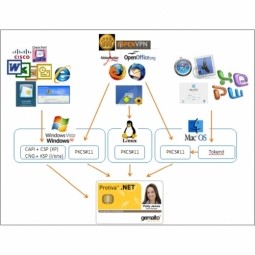Technology Category
- Analytics & Modeling - Machine Learning
- Analytics & Modeling - Predictive Analytics
Applicable Industries
- Life Sciences
- National Security & Defense
Applicable Functions
- Procurement
- Quality Assurance
Use Cases
- Inventory Management
- Tamper Detection
Services
- Cloud Planning, Design & Implementation Services
- Testing & Certification
About The Customer
AODocs is a content services platform that is tightly integrated with Google Workspace. It works like a document management layer that sits on top of Google Drive, enabling businesses to organize their data and documents effectively. AODocs allows businesses to establish permissions and ownership controls, automate business workflows, apply retention policies, and comply with standards and regulations. The company is based in the United States and operates in the technology industry. It is the only content services platform that is tightly integrated with Google Workspace, and it aims to reinvent document management by integrating it directly into the Google Workspace environment.
The Challenge
AODocs, a content services platform, was faced with the challenge of integrating document management directly into the Google Workspace environment. The company aimed to provide a solution that would allow businesses to organize their data and documents effectively, establish permissions and ownership controls, automate business workflows, apply retention policies, and comply with standards and regulations, all while saving infrastructure and administrative costs. The challenge was to build a platform that could scale with any project size without impacting the performance of other users on the multi-tenant platform. Additionally, the platform needed to be secure against all possible security incidents, from network intrusions to hackers or denial of service attacks.
The Solution
AODocs chose to build its platform in a serverless Google Cloud environment, using App Engine as the backbone of its cloud stack. This allowed the company to run the primary set of services for its enterprise document management service. Information is stored on Datastore, and BigQuery is used to monitor user activity and gain insights with predictive analytics. The serverless stack on Google Cloud allowed AODocs to scale with customer needs and deliver uninterrupted service. The built-in security features of Google Cloud enabled AODocs to focus all their efforts on the solution itself, knowing that security threats are properly dealt with. Furthermore, App Engine facilitated the management of parallel environments, adapting release cycles to regulatory compliance needs.
Operational Impact
Quantitative Benefit

Case Study missing?
Start adding your own!
Register with your work email and create a new case study profile for your business.
Related Case Studies.

Case Study
Data Capture for Afghanistan Forces
Electronic equipments on the field of Afghanistan provided information on the status of the vehicle and to identify potential threats surrounding it to the British Force. The monitoring and interpretation of this data requires robust and sophisticated digitization for data capture and communication.

Case Study
Corporate Identity Solution Adds Convenience to Beckman Coulter
Beckman Coulter wanted to implement a single factor solution for physical and remote logical access to corporate network. Bechman Coulter's users were carrying smart card badges for doors, but also needed a one-time password token to access to our corporate network when they were not in the office. They wanted to simplify the process.
Case Study
Enhancing Security and Compliance in Remitly's Global Money Transfer Service with Fastly
Remitly, an online remittance service, was faced with the challenge of securing its proprietary global transfer network. The company needed a security solution that could meet PCI requirements and protect customers' sensitive transactions through its mobile application. The solution had to be capable of defending against new and emerging attack types without impacting performance. Remitly also had to deal with irregular traffic patterns, such as a sudden spike in account transfers from a small network segment on the Pacific coastline of South America. The company needed to determine in real time whether such traffic indicated an attack or valid requests. A traditional web application firewall (WAF) would not be able to distinguish this traffic, potentially leading to customer frustration if the IP was blacklisted.

Case Study
Embracing Business Success in Real Time
· Increase control over growing Big Data to improve business decisions · Manage data for 28,000 biotechnology stockkeeping units in the fields of microbiology, molecular biology, animal cell cultures, plant tissue cultures, and lab ware for laboratory chemicals · Accelerate report generation and analysis with real-time data

Case Study
Major Aerospace Company Automates Asset Management
The O&M division of an aerospace and global security company was using spreadsheets to manually track more than 3,000 assets assigned to students and staff. Maintaining audit trails for this high volume of equipment became increasingly time-consuming and challenging. The chore involved knowing precisely what equipment was on hand, what had been issued, its location and the name of the custodial owner of each item. Every aspect of this task was carried owner of each item. Every aspect of this task was carried out by individuals with spreadsheets. Manually documenting the full lifecycle of each asset added to the burden. This included tracking maintenance requirements and records, incidents and damages, repairs, calibrations, depreciation, and end-of-life data.

Case Study
Securing a Large Data Center in the EMEA Region: An IoT Case Study
A leading data-center operator in the EMEA region, with multiple facilities spanning over 25,000 square meters, faced significant security challenges. The operator experienced interruptions in their internal IT network due to unsupervised work of third-party technicians. Despite having a high-end building control system that provided 24x7 monitoring and control to all the building’s infrastructure, the data center was vulnerable from a cyber perspective as it was connected to the IT network infrastructure. The operator launched an urgent OT cyber security project that included both IT-OT network segmentation and OT network asset mapping and anomaly detection. The main objectives were to harden the security of the server systems, secure the facility’s power supply and server cooling system, strengthen the segmentation between building and operational systems, create a visual OT network map, and set up a system for presenting supply-chain attacks that may threaten the data center through equipment vendors’ maintenance activities.







